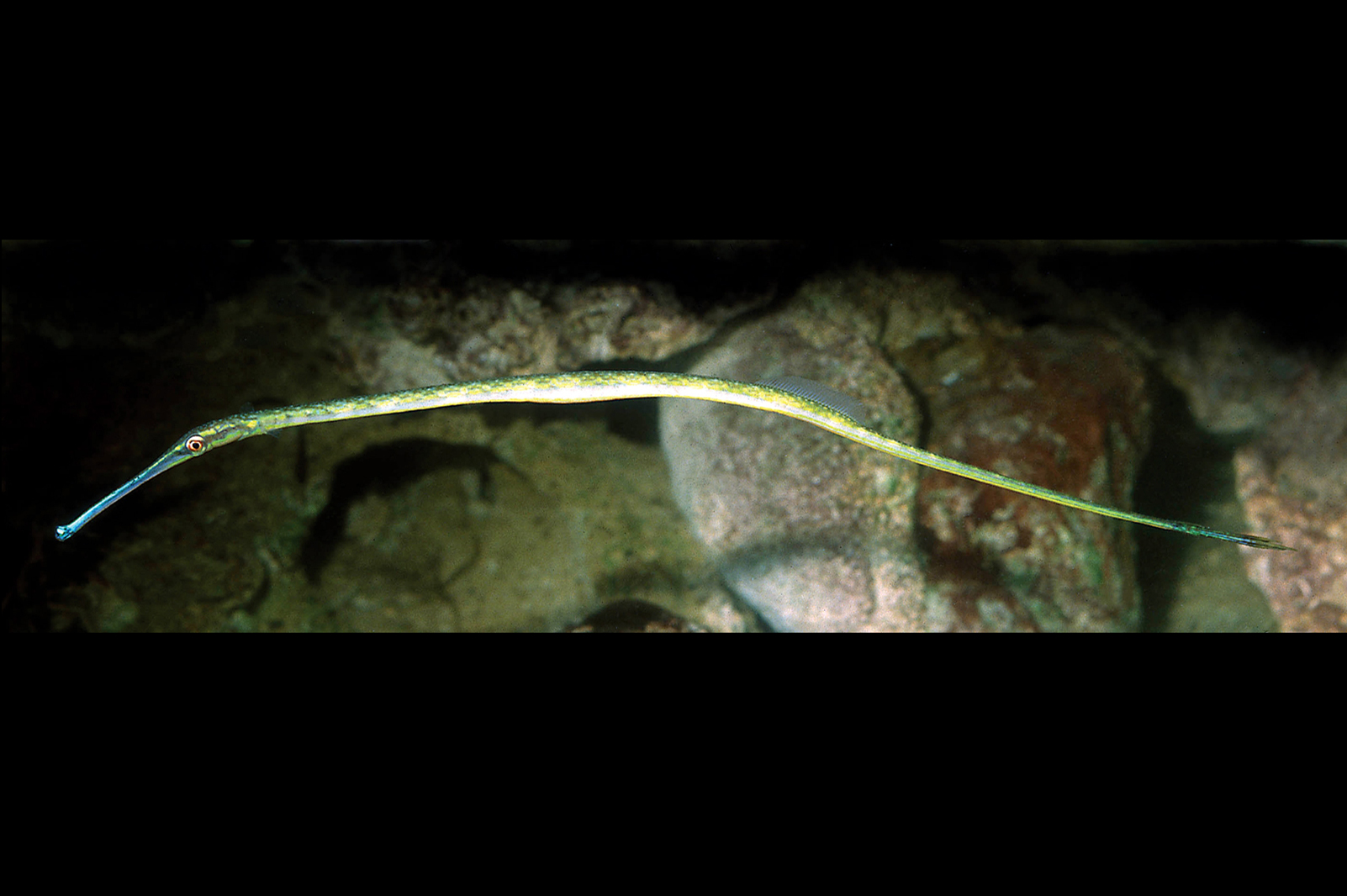Brushtail Pipefish, Leptoichthys fistularius Kaup 1853

Brushtail Pipefish, Leptoichthys fistularius. Source: Rudie H. Kuiter / Aquatic Photographics. License: CC by Attribution-NonCommercial
A large well-camouflaged pipefish with a large "brush-like" tail and a long snout.
Brushtail Pipefish, Leptoichthys fistularius Kaup 1853
More Info
|
Distribution |
Endemic to temperate waters of southern Australia, from northern Tasmania and Corner Inlet, Victoria, to Albany, Western Australia. Inhabits inshore sheltered seagrass beds, mainly Zostera, but also Posidonia beds. |
|
Features |
Dorsal fin 33-41; Anal fin 5; Pectoral fin 20-23; Caudal fin 11; Trunk rings 22-28; Tail rings 18-24; Subdorsal rings 3.5-2.00 + 5.00-6.75 = 7.75-9.25. Body very slender, elongate, trunk shallow; head aligned with body; snout long, laterally compressed, snout length 71-77% HL, snout depth 4-7% snout length; longitudinal opercular ridge usually crossing anterior half of opercle in young, absent in adults; superior trunk and tail ridges discontinuous near rear of dorsal-fin base; inferior trunk and tail ridges continuous; lateral trunk ridge not confluent with tail ridges; tail not prehensile; adult females with median longitudinal fleshy finfold under tail. Dorsal fin much closer to tip of tail than to head, base of moderate length; anal fin very small, below centre of dorsal fin; caudal fin very long, more or less lanceolate. |
|
Size |
Reaches at least 65 cm TL. |
|
Colour |
Mainly greenish brown, head and dorsum of trunk darkest and marked with orange-brown wavy lines; caudal fin brownish shading to near-black distally. |
|
Fisheries |
|
|
Conservation |
Australian Government Legislation: Marine listed under the Environment Protection and Biodiversity Conservation Act 1999. State Government Legislation: All species of the Syngnathidae are listed as protected under New South Wales, Victorian, Tasmanian and South Australian Fisheries Management Acts. |
|
Remarks |
Juveniles often swim in small groups. |
|
Similar Species |
|
|
Etymology |
Leptoichthys is from the Greek leptos meaning thin and ichthys for fish. The species is named fistularius as head shape resembles that of the flutemouths in the family Fistulariidae. |
|
Species Citation |
Leptoichthys fistularius Kaup 1853, Arch. Naturg. 19(1): 233. Type locality: King George Sound, Western Australia (as Port du Roi George). |
|
Author |
Bray, D.J. & Thompson, V.J. 2018 |
|
Resources |
Brushtail Pipefish, Leptoichthys fistularius Kaup 1853
References
Dawson C.E. (1985). Indo-Pacific Pipefishes (Red Sea to the Americas). Gulf Coast Research Laboratory, Ocean Springs, Mississippi. 230 pp.
Dawson C.E. (1994) Family Syngnathidae. pp. 440-474 figs 391-426 in Gomon M.F., Glover C.J.M. & Kuiter R.H. (eds) The fishes of Australia's south coast. Adelaide: State Print 992pp 810 figs.
Kuiter R.H. (1993) Coastal Fishes of South-eastern Australia. Crawford House Press, Bathurst 437pp.
Kuiter, R.H. (2000) Seahorses, Pipefishes and their Relatives. Chorleywood, UK: TMC Publishing. 240 pp.
Pogonoski, J.J. Pollard, D.A. and Paxton, J.R. (2002) Conservation Overview and Action Plan for Australian Threatened and Potentially Threatened Marine and Estuarine Fishes, Canberra Environment Australia 375 pp.
Pollom, R. 2016. Leptoichthys fistularius (errata version published in 2017). The IUCN Red List of Threatened Species 2016: e.T65369313A115425337. http://dx.doi.org/10.2305/IUCN.UK.2016-3.RLTS.T65369313A67624170.en. Downloaded on 22 October 2018.




